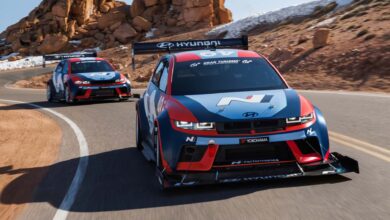What Is a Mustang Dark Horse? It’s More Great Branding From Ford

[ad_1]
The Dark Horse name is just clever marketing. But it works.


May 28, 2024 at 12:00pm ET
I was sitting at a stoplight recently when I saw a hand flailing in the corner of my eye. It was a Toyota Tacoma driver ushering me to roll my window down, so I did. They yelled: “What model year is that car?”
I told them it was the 2024 Ford Mustang Dark Horse with a manual transmission. They thanked me, the light turned green, and we sailed away—them with an inoffensive glide and me with a loud, gurgling Coyote V-8. If I’d been driving any other Mustang, I don’t think they would’ve cared. But Dark Horse is different. This car is edgy and mysterious, courtesy of its new name, low growl, and blacked-out style.
It’s just branding, but it works.
The Mustang Dark Horse is the first new performance nameplate for the model since the Mustang Bullitt debuted in 2001. Ford brands the Dark Horse as “the horse you didn’t see coming,” and it’s accurate. Aside from trademark filings in 2022, the Dark Horse debut was a surprise.
You might think: “The Mustang has been around since the 1960s, and it has all sorts of branding: Shelby, Boss, Mach 1, Bullitt, SVT, and more. Why spend all that time to create a new Mustang nameplate, especially when V-8 muscle cars are dying?” On the surface, that’s a fair point.
This car is edgy and mysterious, courtesy of its new name, low growl, and blacked-out style.
But Mustang brand manager Jim Owens has said the “Dark Horse” branding is meant to bring the Mustang into the future. It’s for people—perhaps younger ones—who might gloss over a traditional Mustang moniker simply because they’ve seen it before. It makes sense; the Dodge Hellcat is one of the coolest nameplates on the market, yet you’d be forgiven for not frothing over it every new model year. Even cool things become routine after a while.
The Dark Horse breaks that routine. It’s got giant black hood graphics; thick, eyeliner-style panels around its headlights; and the first front-facing horse logo on a Mustang. The Dark Horse logo stares at you straight on, nostrils flaring like a racehorse, mirroring the dual nose openings on the Dark Horse.
Those openings feed air to the Dark Horse’s 5.0-liter, naturally aspirated Coyote V-8 engine, which makes 500 horsepower and 418 pound-feet of torque. It’s paired with either a six-speed Tremec manual transmission or a 10-speed automatic, sending power to the rear wheels. (If you want the auto, it’ll cost you $1,600 extra.) It’s the most powerful naturally aspirated 5.0-liter V-8 in Mustang history, and its base price is $58,185.
The Dark Horse currently slots in above the Mustang GT, which has a $41,960 base price. The GT has 480 horsepower as standard and can be optioned to 486, and it’s also available in a (non-Tremec) manual or an automatic. The major difference with the Dark Horse isn’t the power; it’s the added performance bits, the advertised “limited availability,” and perhaps most importantly, the branding.
I remember the first time I heard about the new Dark Horse. The name immediately caught my attention; like “Hellcat,” it’s just a captivating term. It also looked like a new genre of Mustang that was dark, moody, and more modern. I knew it wouldn’t be the most revolutionary driving experience in the world—the Mustang is already great—but its attitude compelled me.
The Dark Horse is a dream to drive, too. It’s fast as hell, loud as hell, and it handles corners better than any straight-line American muscle car should. It’s comfortable on the highway (so long as you don’t watch the fuel gauge constantly tank), and there’s plenty of room in the front seats and trunk. The back seats can fit adult humans, but not comfortably.
The manual shifter perfectly notches up and down into place, and the Dark Horse’s no-lift shift technology feels like magic. In most manual cars, drivers have to take their foot off the gas, press the clutch pedal, then shift into a higher gear. With no-lift tech, you can keep your foot pinned on the accelerator while upshifting during hard acceleration. The Dark Horse takes care of the rest, giving you a faster shifting motion and the satisfaction of breaking the rules without consequences.
The Dark Horse isn’t perfect. Its infotainment screen went black a few times while I had the car, forcing me to restart it; it’s built for four seats, but not four people; and the blacked-out eyeliner around the headlights makes it look kind of like a Teenage Mutant Ninja Turtle robbing a bank. But those are my only real complaints about the car.
I remember the first time I heard about the new Dark Horse. The name immediately caught my attention; like “Hellcat,” it’s just a captivating term.
Plus, the Dark Horse as a branding exercise is perfect. It avoids any baggage that comes with old Mustang nameplates, and it forces onlookers (and potential buyers) to look. To create a “new” car with cool, new branding keeps people from glossing over it, like the Tacoma driver I saw.
In a world where there are so many distractions, getting someone’s attention can be even harder than keeping it. The Dark Horse solves that problem, giving the car’s style and performance a chance to speak for themselves—and they do.
To me, that’s a win.
Photo Credit: Alanis King for Motor1
Read more
[ad_2]
Source link




